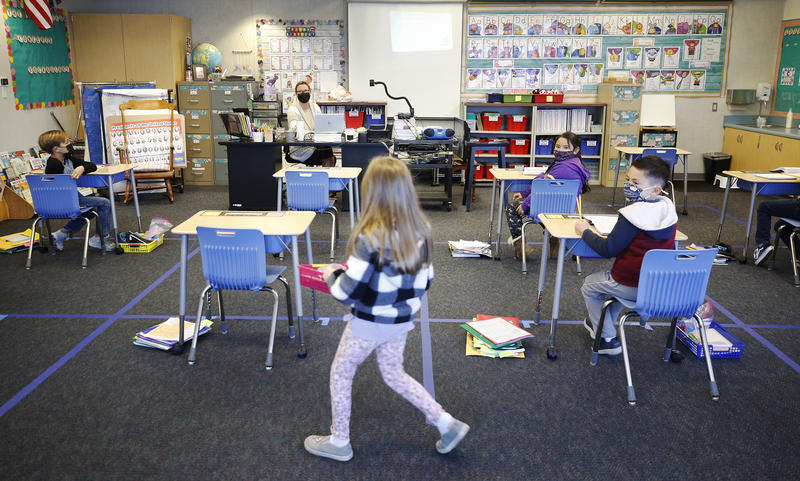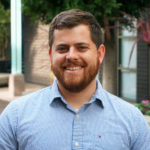Teachers are returning to the classroom with mixed feelings of excitement and anxiety as they ease students back into classrooms after 17 months of distance learning, according to a panel of educators during an EdSource Roundtable Discussion, the second in a new series.
They say they have their work cut out for them this year as they address the social anxiety that many students are now feeling, the technology burnout students face and as they balance academic curriculum with social-emotional learning.
Jose Rivas, who teaches physics and engineering to grades 10–12 at Lennox Mathematics, Science and Technology Academy in southwestern Los Angeles County, said his students were eager to return to the classroom, where they could “get their hands dirty” building things. But, he said, many felt anxious about being back in the classroom. One of his students became physically ill because she felt overwhelmed being in a room with so many people. Rivas said all he could do was give the student some space until she felt better.
Gwendolyn Delgado, a bilingual 6-12 teacher at La Mesa Junior High School, said social anxiety was clearly apparent among students in her ethnic studies class, where she frequently has students turn to their partners to have conversations. Despite being excited to come back to school, the students struggle to spark conversations while wearing masks and following the school’s other safety protocols. They ask a lot of questions about what they are and aren’t allowed to do.
“The kids are very hesitant,” Delgado said. “Part of it is because of all the guidelines and restrictions that we have in the classroom. But, also, they’ve been isolated and been on their own and now to have these social interactions with all these restrictions, they don’t know what to do.”
Delgado said one of the things she does to bring down students’ anxiety is to sanitize the classroom and materials, such as art supplies. It’s not required at her school, she said, but it makes students feel more secure.
Rivas and Delgado are part of EdSource’s Teacher Advisory Committee.
In order to make students comfortable participating in the class, Rivas said building relationships and community is key. Panelists spoke to the importance of social-emotional learning: education based on helping students develop emotional skills like self-awareness and navigating healthy relationships vital to success in school and life. Some examples include meditation and mindfulness exercises and communication and collaboration skills.
“For me, academic curriculum is on the backburner,” Rivas said. “These kids just want to talk, they want someone to say, ‘Hey I noticed that you like anime, let’s talk about it.’ It’s not pushing the curriculum on them, they’re going to get through the stuff, and we’re going to learn, but that interpersonal relationship building with the teacher and the other students is critical.”
When students get to the point of feeling comfortable with their teacher and classmates, they’re more willing to share how they are feeling that day, or troubles they may have in their lives, he said.
“That’s why we’re here, right? It’s not just to shove curriculum into their minds, but to understand that they are people, and they need to be heard and they need to be safe,” he said.
Despite teachers’ best efforts, there will still likely be students who just won’t want to participate, Delgado said.
“You can’t push it on them right now, you can’t force them,” Delgado said. “You’re just going to have to respect that they need that individual space, and maybe talk to them after class and say ‘Hey is everything OK? I just wanted to check in with you, maybe we can try again tomorrow, and if you need support let me know.’”
In order to gauge where students are at academically going into the new school year, Rivas said he takes an “individualized approach” to each of his students. He has an individualized education plan for all of his more than 130 students. Individualized education plans, or IEPs, are typically developed for students with special needs. They outline what that student needs to learn in a specified period of time and what special services need to be provided based on the student’s ability.
Rivas said he incorporates social emotional learning into his student’s IEPs.
Something the roundtable panelists have in common is that their students are feeling burnt out on technology. Some said students complain when they have to use the computer. They would rather do art, use pencil and paper, and do more hands-on activities, which they lacked during distance learning.
“I felt the burnout amongst our students, and myself as well,” Delgado said. “I needed to unplug just for my own wellbeing as well as being an educator. I find that my students are enjoying (unplugging). It’s pushing them to be more creative on their own and come up with thoughts on their own instead of just Googling a thought.”
Delgado said she will continue to integrate technology in her classes — especially for students who are shy in order to get them to participate more.
Larry Ferlazzo, an English and social studies teacher at Luther Burbank High in Sacramento, said he plans to give students the option of doing projects or activities using either pen and paper or something like Google Slides. He said it’s important to keep in mind that students and classes may go into quarantine, so having an online option for schoolwork may be necessary.
For more on this EdSource Roundtable topic, please watch the video above.
To get more reports like this one, click here to sign up for EdSource’s no-cost daily email on latest developments in education.















Comments
Comments Policy
We welcome your comments. All comments are moderated for civility, relevance and other considerations. Click here for EdSource's Comments Policy.